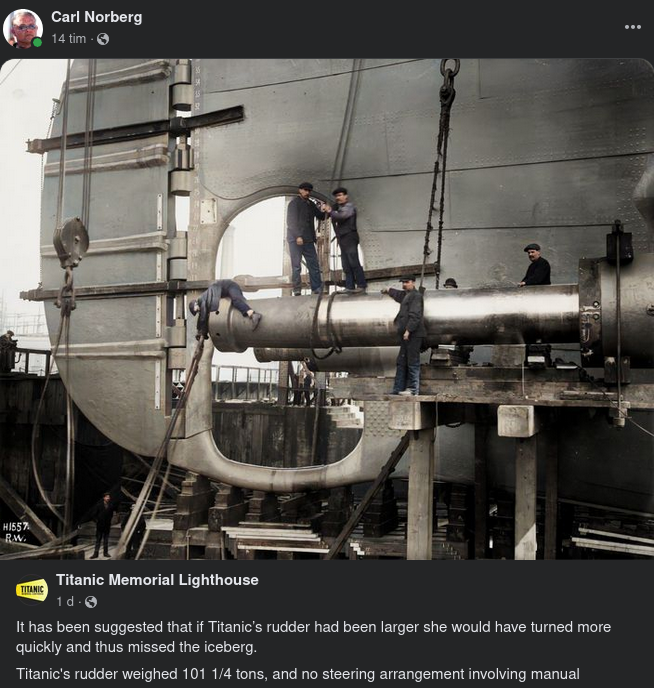Titanic & Olympia
2023-04-29

It has been suggested that if Titanic’s rudder had been larger she would have turned more quickly and thus missed the iceberg.
Titanic's rudder weighed 101 1/4 tons, and no steering arrangement involving manual power—regardless of how much leverage was in the system—would have sufficed to move it.
The Steering Gear Room was housed in the most aft location of C Deck, beneath the Poop Deck and just astern of the Third Class General and Smoke Room. It held the ships Servo Equipment, which consisted of: tiller, steering gear, rudder shaft, steering engines.
The steam valves of these engines were connected to the Main wheel in the Wheelhouse via hydraulics (Browns Patent Telemotor). Due to the Servo Equipment there was a 30 second delay after moving the wheel, and many claim this contributed to the collision with the iceberg.
The usual way of determining the proper size of a rudder is to compare the area of the rudder to the longitudinal area of the ship’s hull on the centerline, or LBP x Draft. The rudder area for fast ships should be 1/60th of hull area, and 1/70th for slow ships.
Titanic’s LBP was 850 feet and her full load mean draft was 34.5 feet, so her longitudinal area on the centerline was 29,325ft squared.
Travelling at about 22 knots and seeing the iceberg at only about 500 yards, Titanic had no more than 30 seconds to avoid the ice.
During this time she managed to turn two points to port before swinging her bow to starboard, successfully clearing her stern away from the iceberg.
Important to note is that Titanic had exactly the same size rudder as Olympic had throughout her career, and Olympic’s wartime captain described her as the most maneuverable and responsive ship he had ever had the pleasure to command.
The very efficient steering of Olympic-class liners was due to the advantage that their central propellers were directly ahead of the rudder, which therefore increased the rudder’s effectiveness due to the increased slipstream produced by the central propeller—a feature lacking in Cunard’s quadruple-screw Mauretania and Lusitania.
Olympic’s captain was even able to suddenly and deliberately steer into a German submarine, ramming and sinking it thereby giving Olympic the distinction of being the only merchant ship to sink an enemy vessel during the First World War.
Titanic’s rudder was in fact 2% too small, but all evidence suggests she turned very well.
Not much is left of this room in the wreck, since the storage rooms beneath it were filled with air when the ship dragged down. The pressure caused the rooms to implode and collapse, destroying the equipment. It is said that the storage rooms filled with water and the pressure forced upward, causing a high pressure jet of water to peel the decking back.
Here, the rudder and starboard shaft of Titanic. Note the braces on the rudder to keep it at 0º during launch.
Visa ditt stöd till det informationsarbete Carl genomför
Patreon
Swish

Scanna QR eller skicka till 076-118 25 68. Mottagare är Caroline Norberg.
